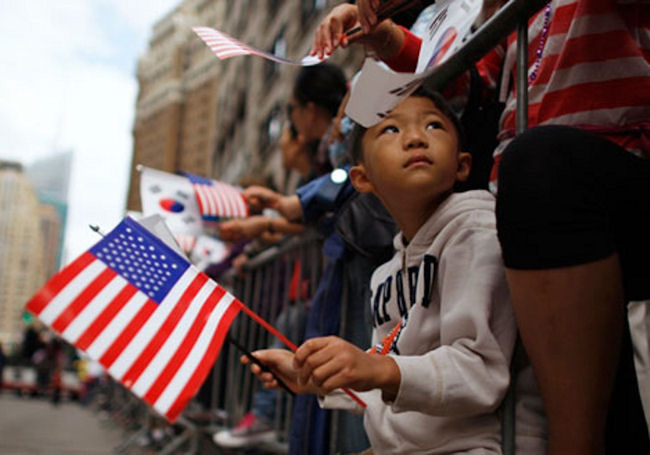
On Tuesday, America will mark yet another Election Day. For Asian Americans and Pacific Islanders (AAPI), this coming election seems particularly relevant.
The AAPI electorate is among the fastest growing voter population in the country. In the last two presidential general elections, AAPI voters voted overwhelmingly in favour of Barack Obama. In several states during the 2012 election, AAPI voters voted for the incumbent president in large enough numbers to have likely swung their states into his column. With Election Day fast approaching, many of us have been reminded of the power of our vote. We have been the target of exhortations to turn out to the ballot box on November 8th. It has been widely speculated that AAPI voters and other voters of colour – who collectively support Democratic nominee former Secretary of State Hillary Clinton by three-to-one margins – are likely to win the first female president of the United States her place in the Oval Office.
It seems obvious that greater electoral numbers for AAPIs should yield concomitant greater political power for our community. America is a representative democracy, wherein constituents are promised a seat at the table by a simple sociopolitical contract: our votes are offered to politicians as a quid pro quo promise of beneficial policy changes. More votes might therefore be assumed to invite better policies. Indeed, some AAPI groups – most notably 80-20 — deploy such thinking as rationale for their mission to create a national AAPI voting bloc comprising 80% or more of all voting Asian Americans and Pacific Islanders; the group’s leaders seek to leverage that bloc for or against specific candidates.
But what if this thinking is flawed; or, at least, incomplete? What if sheer voting numbers do not alone guarantee greater political power for voters on the fringes of American politics? How do AAPI voters, and other voters of colour, build political power when we must cast our votes in a system structurally resistant to prioritizing issues of race and racism?
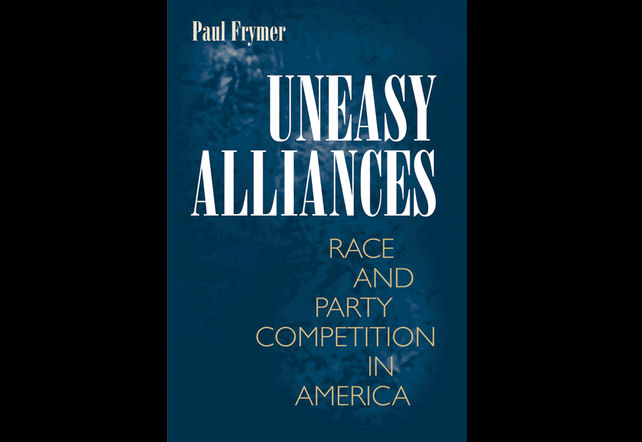
“Captured Minorities”: When American Politics Ignore Race
To answer the question of how AAPI voters might political power in America requires that we first consider existing political science on (non-AAPI) minority voters.
Paul Frymer observes in his book, “Uneasy Alliances: Race and Party Competition in America”, that despite decades of high voter turnout and consistent Democratic voting trends, Black voters are routinely failed by America’s political system. Black voter turnout is consistently among the highest in the nation, reaching nearly 60% during the historic 2008 presidential election. Since the Voting Rights Act of 1964, Black voters have also consistently voted Democrat by at least two-to-one (and typically larger) margins, in both up-ticket and down-ticket races.
And yet, Black interests remain almost entirely unaddressed by mainstream politics. Our mass incarceration state continues to shuttle Black youth from classrooms to jail cells. Key components of the 1964 Voting Rights Act were recently overturned by the Supreme Court with no evidence that Congress intends to pass corrective legislation; as a consequence, Black voters are being disenfranchised in record numbers by laws that deliberately and disproportionately target Black and other underprivileged voters. Black civilians are shot and killed by police at rates far greater numbers than for most other groups, and yet our politicians still struggle to openly agree that Black lives, indeed, should matter.
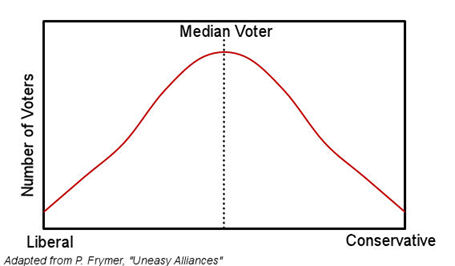
Frymer offers the following explanation for this failure. Party officials in America’s two-party system are largely preoccupied with electing large numbers of candidates to office. Given these motivations and America’s “winner-take-all” elections system, elections become a ‘race towards the middle’ as both major political parties compete to woo the ideologically moderate, median (White) voter.
Many suggest that in such a system, the interests of marginalized groups – such as Black voters – are addressed simply because those voters exist within a common political arena wherein either major political party must forge a majority coalition by appealing to distinct electorates.
Even so, Frymer argues that Black voters find no return on their unwavering commitment to the Democratic party. This occurs because both parties believe that the coveted undecided White moderate is disdainful to (if not outright hostile to) efforts that advance Black representation – a belief borne out by American history. Furthermore, the median voter who is turned off by a racial agenda remains attractable on non-racial issues — so long as topics of race are avoided altogether. Consequently, the party ideologically closest to the Black community is incentivized to dismiss Black interests, while the opposition party launches racialized attacks on the Black community; both are tactics deployed to appeal to the White moderate. For empirical evidence, we might turn to a recent study showing that as support for a proposed legislation rises in the Black community rises, its chances of passage decreases.
Ironically, Donald Trump succinctly described the conundrum when he said at a rally in Michigan: “Our government has totally failed our African American friends, our Hispanic friends and the people of our country. Period.” While Trump is wrong to describe Black neighbourhoods as if they are war-torn scenes of the apocalypse, it is true that the Democratic party has routinely supported legislation damaging to the Black community. The Clintons were the architects of a crime bill that form the foundation of the current mass incarceration state; Hillary Clinton publicly justified the bill by invoking the myth of the young black “superpredator” who had to be brought “to heel”. At a more recent debate appearance in the 2016 campaign season, Clinton criticized stop-and-frisk as unconstitutional, but later offered praise for its effects. “New York has done an excellent job” in reducing the city’s crime rate, she said, giving credit “across the board … [to] two mayors, two police chiefs, because it has worked.”
Of course, neither Donald Trump nor the Republican Party promises better treatment for Black voters.
Therefore, the Black voter – finding neither party an interested advocate – becomes electorally “captured”, consigned by the absence of meaningful choice to vote between two parties, neither of which can or will deliver more effective representation for Black voters.
Lessons for the AAPI Electorate: Are We Headed for Capture?
Electoral capture occurs when a political party can rely so consistently upon support from a non-White electorate that they are no longer incentivized to appeal to those voters. Black voters have voted with Democrats since the 1960’s and most political scientists describe this electorate as effectively captured by the American Left.
Analysis of AAPI voting patterns also suggest that AAPI voters are headed left. Persuaded in part by model minority stereotypes, conservatives frequently characterize AAPI voters as “naturally conservative” and thus potentially receptive to Republican appeals. They might point to the fact that in the late 1980’s and early 1990’s, a majority of Asian American voters were registered Republican. In 2013, GOP chair Reince Priebus expanded efforts to appeal to the AAPI electorate in hopes of expanding the Republican base. Yet, the National Asian American Survey (NAAS) notes that nearly 60% of AAPI voters are registered Democrats or left-leaning independents, compared to only 24% of Republicans and right-leaning independents. Since 2000, a growing percentage of Asian American voters have voted with Democratic candidates. In 2008 and 2012, Asian American voters supported Barack Obama by three-to-one margins, and similar voting patterns are predicted for 2016’s Election.
Dogma within political science states – if largely without any convincing empirical evidence – that an electorate becomes committed to a particular major political party after three successive elections wherein they vote overwhelmingly in favour of that party over the opposition.
Thus, as AAPI voters establish a growing commitment to the American left, we must ask: Are AAPI voters also headed for electoral capture?
To answer this question, we must first ask why AAPI voters are increasingly voting with the Democrats. The New York Times has noted the leftward trend of the AAPI electorate, and further suggests that Donald Trump’s anti-Asian race-baiting has “pushed Asian Americans into Democratic arms.” This is short-sighted analysis: the AAPI community’s abandonment of the American Right precedes Donald Trump, and it occurs for good reason.
Frymer suggests that a spectrum of liberal-conservative racial attitudes might be considered as a distinct axis from the more classic left-right ideology of American politics. Given that, both parties might seek to expand their base by appealing to ideologically similar, but racially conservative, voters. However, with the rhetoric of the 2016 election, we can no longer consider race and identity politics to be a distinct axis from that of the conventional liberal-conservative axis. The American Right’s steadfast embrace of nativist xenophobia produced the appallingly racist Watters’ World: Chinatown Edition segment by Fox News that angered the AAPI community. It has further culminated in Republicans’ nomination of Donald Trump, a candidate whose overt race-baiting invokes the ghost of George Wallace (and Denis Kearney before him). Many have now suggested that Trump’s popularity is carried by a resurgent White identity politics that is overtly hostile to multiculturalism. In other words, Republicans have become the party of ethnic nativism and racial monoism; Democrats have conversely become the party of pluralism.
When one major political party is the party of monoism and other is the party of pluralism, Black voters – and indeed, all voters of colour, including AAPI voters — lose out. The racial monoism of the American racism opposes our citizenship, dismisses our interests, and would revoke our very presence in America. No self-respecting voter of colour can cast a vote for a party whose central ideology denies that voter’s legitimacy.
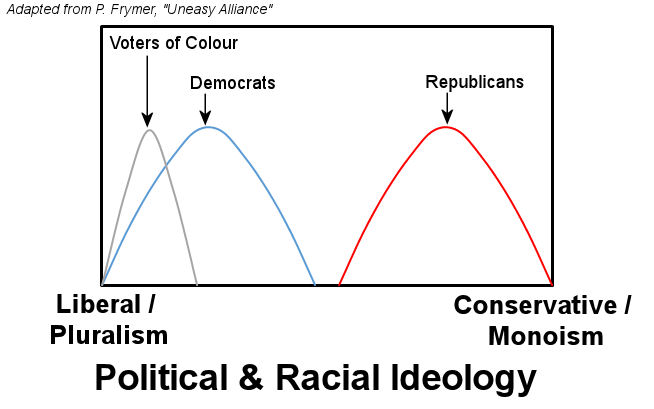
Consequently, when the liberal-conservative axis becomes indistinguishable from a pluralism-monoism axis, voters of colour can no longer occupy the full range of the spectrum. The median voter of colour is forced to the left of the political and racial spectrum, not necessarily out of political ideology but out of recognition of our own humanity.
This is a damning status quo. When one party is not just disinterested but actively hostile towards the existence of people of colour, the other party loses any remaining incentive to meaningfully advocate for our interests. Democrats may offer political sanctuary for voters whose very existence must oppose racial monoism; and, they may even devote resources to turning out marginalized voters to fundraising events or to the polls on their behalf; but, neither act guarantees much more than nominal integration of pluralist policies into official party platforms. Hacked emails from the Democratic Congressional Campaign Committee advised candidates not to “offer support” for “concrete policy positions” of Black Lives Matter. A search in the Wikileaks-released emails of Hillary Clinton campaign chairman John Podesta for the term “AAPI” retrieves only thirty emails, most of which are only concerned with courting a prominent Asian American donor.
When both parties know that more than three-quarters of non-White voters are currently voting for the Democrats, that undecided White median voters continue to disdain policies that might primarily improve the plight of non-White constituencies, and that voters of colour are not free to stage a defection to an opposition party that openly hates us, both parties can pigeonhole our votes while writing-off our interest.
And so, our electoral capture is all but cemented.
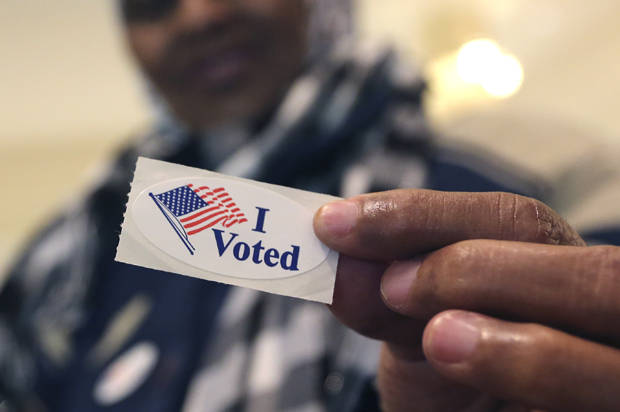
Breaking Free: Existing Strategies for Ending the Capture of Black Voters
Conventional wisdom suggests that breaking electoral capture requires a defection of captured voters from the party with which they are traditionally aligned. But how can marginalized voters stage a defection in the current political climate, and to whom might we defect?
Frymer offers, and ultimately dismisses, the idea that non-White voters might forge a third party. America is notoriously resistant to third party candidates, and third party efforts have never yielded significant mainstream success.
Last month, when I asked an expert in political science about whether AAPI voters might be headed for electoral capture, and whether there might be anything we could do to stop it. I was referred by that scientist to a Time article by Eddie S. Glaude, Jr. (Chair of the Department of African American Studies at Princeton University) and Fredrick C. Harris (Director of the Center on African-American Politics and Society at Columbia University). Glaude and Harris propose the launch of the “Blank-Out Campaign,” wherein Black voters use their vote strategically to demand better reprseentation. Noting that the idea of withholding the Black vote as a protest of electoral capture has been suggested by the likes of civil rights activist James Weldon Johnson in the 1920’s and Malcolm X in the 1960’s, Glaude and Harris write:
This election matters. But African Americans can’t engage in politics as usual. Chronically desperate times call for drastic measures. For too long, African-American participation in the democratic process has been distorted. Republicans show little interest in black voters, and Democrats simply take black voters for granted.
Glaude and Harris propose that Black voters can ensure a Democratic victory while still signaling their frustration towards a rigged political system by casting votes that reduce the Democratic nominee’s vote totals in red-secure states while swinging the election in favor of the Democrats in blue and battleground states.
The process is simple: Black voters turn out in large numbers across the nation. In red states, Black voters vote as usual in down-ticket races, but leave their choice for presidential nominee blank. In all other states and in particular in battleground states, Black voters vote in overwhelming numbers to secure a Democratic victory. This two-pronged approach, argues Glaude and Harris, ensures that Democrats stop taking Black votes for granted by showing how the Black electorate can deliver a presidential election to a Democratic victor but are not captured enough to vote that way blindly.
But, the political scientist who referred me to Glaude and Harris’ writing also suggested that this proposal is incomplete. If indeed all voters of colour are headed towards electoral capture, then the solution to break electoral capture must rely upon a coalitional strategy that draws upon the electoral strength of all voters of colour, not just Black voters. Could it be, suggested the political scientist to me, that the Blank-Out Campaign should be adopted by a multiracial coalition of non-White voters including AAPI voters?
There are several issues to contend with in the proposal that AAPI voters join an effort proposed by Black political scientists to improve Black electoral interests. Beyond legitimate concerns of derailment and distraction, there is a logistical problem: AAPI voters – unlike Black voters – do not live in large numbers in red-secure states or in battleground states; instead, most AAPIs live in blue-secure states such as California, Washington, and New Jersey. Few AAPI live in the battleground states of Ohio, Pennsylvania and Florida. Of red-secure states, only one – Texas – boasts a sizable AAPI population. Thus, even should AAPI voters join the Blank-Out Campaign in large numbers, we simply do not have the voter numbers living in the right parts of the country to help Glaude and Harris’ campaign to succeed.
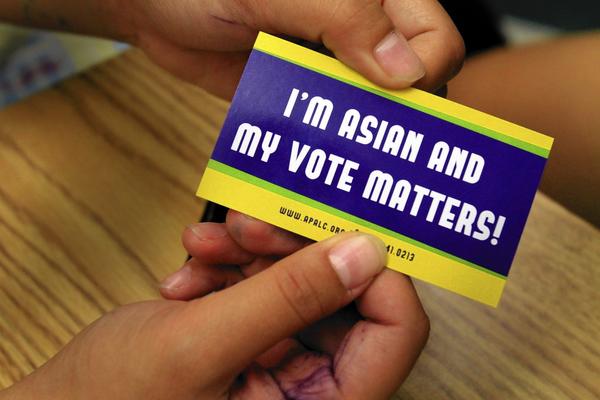
Breaking Free with Down-Ticket Races: How AAPI Voters Can Signal Our Frustration with Electoral Capture
One thing remains clear: AAPI voters must break our pending (I would argue, inevitable) electoral capture. But, given our electorate’s current demographics, it would be difficult for us to stage an effort to swing a national presidential election. But, this does not mean we can have no impact; instead, I am increasingly convinced that 2016 signals an historic opportunity for the AAPI electorate to demonstrate our electoral clout.
To do so, we must focus our efforts not merely on the top of the ticket; instead, we must turn out – and turn out in enormous numbers – for down-ticket races.
The conversation about electoral capture has, to date, focused on national top-of-the-ticket races. Yet, many have noted that the day-to-day business of governing takes place in Congress, and in state and local legislatures. Frymer, himself, finds that both parties race to attract a median White voter, under the assumption that the median White voter can swing an election. That assumption is, of course, true at the national level; but, it is profoundly untrue at the local level.
Given this country’s history of redlining and racial intolerance, American neighbourhoods remain segregated by race; electoral neighbourhoods are drawn along the lines of existing residential enclaves, resulting in districts that are typically dominated by residents of a particular race. Yet, AAPIs, unlike most other racial groups, are more likely to live in mixed White or White-predominant neighbourhoods. Thus, at the local district level, the median and swing voter is, quite often, not a White voter. In many districts, the median swing voter is a voter of colour. In many local districts where AAPI voters live alongside non-AAPI voters, AAPI voters might be the district’s median swing voter.
We can, and should, capitalize on that fact. We must use the 2016 election to show our clout as an emerging electorate. This year, we can do so by voting in unprecedented numbers to help Democrats secure city-level, state-level and federal legislatures. Democratic victories at multiple levels of government are critical to Democrats to ensure that President Clinton can deliver upon her campaign promises; the AAPI electorate can build political power for ourselves by helping to secure those victories.
We must prove on Tuesday that the Democrats need AAPI voters, and that they would take our electorate for granted at their own peril.
Typically, AAPI voters turn out at lower rates than most other voters, and few voters – of any race – pay much attention to the lower half of their ballot. Often, voters vote down-ticket at random, or even leave the lower half of their ballot blank. This Tuesday, we must reverse that trend.
This Tuesday, we must turn out the AAPI vote at unprecedented levels to maximize our impact. At the top of the ticket, we can vote as we plan to – according to national surveys, most of us will probably vote for Democratic nominee Hillary Clinton. It is the down-ticket races, however, where we can amplify the impact of our small but growing electorate: this year, we must fill in a vote for every down-ticket race. In down-ticket races where a voter has already decided on a candidate, they should vote for their favoured candidate. However, in any down-ticket race where an AAPI voter genuinely has no preference, they should consider casting a vote for the Democrat. (In situations where two Democrats are running against each other, the AAPI voter should vote for the Democratic incumbent; if neither is an incumbent, vote for the candidate who has Democratic establishment backing). We should do this regardless of the state we live in.
Given that most voters in general either abstain from voting in most down-ticket races or vote only for candidates who share the party of their top-ticket choice, if AAPI voters can accomplish this in large numbers, we are likely to help decide many races at the local level. This would result in a Democratic sweep in city councils and state legislatures which would likely translate into better local legislation for marginalized residents.
At the federal level, we can tighten the margins in congressional and senate races – even in red states — and in some close races, we can even help Democrats secure at-risk seats. By choosing the incumbent Democrat in races where two Democrats are competing, we further ensure that we elect a Democrat with existing institutional ties. Such incumbents are typically more productive and more courageous in Congress than junior politicians, and so we return a representative who is more likely to be amenable to passing legislation that directly addresses our interests.
Of course, one might wonder how AAPI voters can break electoral capture by voting for the party that already threatens to capture us. The answer is simple: breaking electoral capture requires that we communicate to political party officials that our electorate is sizable enough to shape elections, that we are uncommitted enough to vote strategically (and in some cases to split our tickets), and that we are angry enough to — as Malcolm X once suggested — wield our ballots like a bullet. In 2016, we can defy electoral capture by demonstrating our power at the ballot box, and by helping to deliver an across-ticket win for Democrats at multiple levels of government. To do so would remind Democrats that they can no longer afford to ignore the interests of the AAPI electorate, or indeed, of any voter of colour.
This year, AAPI voters have an opportunity to stage a revolt against an electoral system stacked against voters of colour. Please join this revolution by making sure you vote – and, in particular, that you vote down-ticket — on Tuesday, November 8th.
* * *
You can find your polling location using this tool by APIAVote and you should know your voting rights by checking out these fact sheets by AALDEF.
AALDEF and APIAVote are also organizing methods for reporting voting irregularities. If you experience barriers at the polls, call AALDEF’s multilingual hotline (800-966-5946), or e-mail them at [email protected]; or call APIAVote’s hotline at 1-888-API-VOTE (1-888-274-8683).
Both AALDEF and APIAVote are non-partisan voting rights and voting turnout organizations who were not involved in the writing of this post and who do not endorse any particular candidate or party.
Many thanks to A. and Snoopy for their comments and suggestions.


